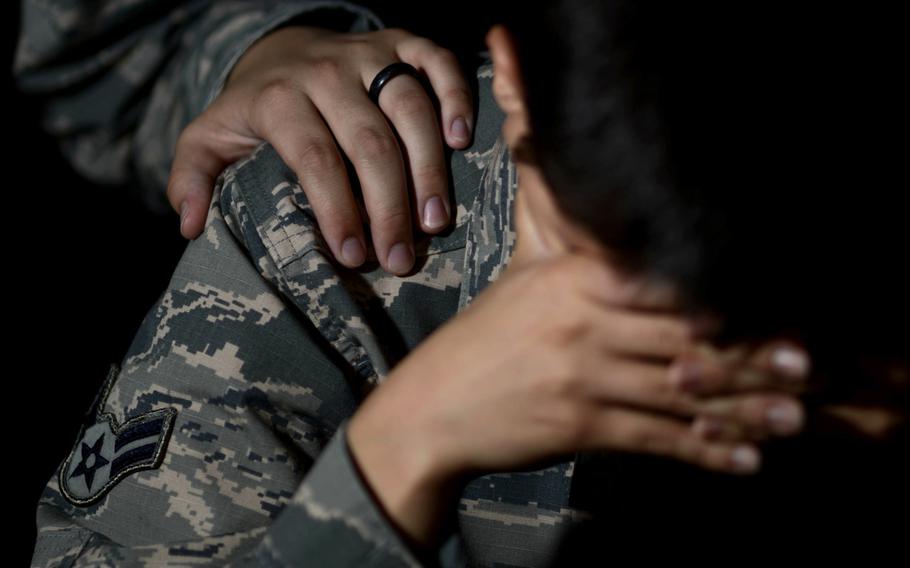
(U.S. Air Force)
WASHINGTON — For the first time, the Defense Department has gathered data on military family members who died by suicide — 186 in 2017 — according to a new report released Thursday.
The DOD started to track family members for its first-ever Annual Suicide Report because they are “an integral part of our military community,” said Karin Orvis, director of the Defense Suicide Prevention Office at the Pentagon.
Since this is the first year of data on spouses and family members age 12 to 23, the Pentagon is cautious about assessing any trends, Orvis said.
“We don’t know if this is a typical year, if this would be an atypical year; we won’t know until we continue to collect this data annually,” she said.
The rate of dependent suicide, using data from 2017, was 6.8 per 100,000. That is comparable to or lower than the rates of the U.S. population after adjusting for age and gender. Dependents of active-duty servicemembers had the highest rate – 7 per 100,000. The rate for reserve forces was 6.2, and the National Guard rate was 6.5.
The majority of spouses who died were female (69%) and under 40 (82%), which reflects the demographics of the overall military spouse population.
In addition to the data on dependents, the report provides the official count and rates of servicemember suicides per calendar year, starting with 2018.
The report’s data is organized by troops serving in the National Guard, reserves, and servicemembers who on are active duty in the Army, Marines Corps, Navy, and Air Force.
According to the report, 541 servicemembers who died by suicide, including active duty, National Guard and reserve members, increased from 511 in 2017 and 482 in 2016.
The annual suicide count by service:
Army: 187 soldiers, with 139 active duty and 48 reserve. Marine Corps: 77, with 58 active duty and 19 reserve. Navy: 79, with 68 active duty and 11 reserve.Air Force: 63, with 60 from active duty and three reserve.National Guard: The Army National Guard had 118; the Air National Guard had 17.
The National Guard had the highest rate of suicide at 30.6 per 100,000. The rate for active-duty servicemembers was 24.8 per 100,000 and for reserve forces, it was 22.9 per 100,000.
When looking at trends for the past five years, the report found a statistically significant increase in suicides of active-duty servicemembers, Orvis said, with an increase of 6% on average each year. However, when looking at the past two years, the rate has statically stayed the same. The rates for Reserve and National Guard suicides for the past two and five years have remained steady, she said.
“The rates are not where we want them to be,” Orvis said. They’re not in the direction that we want them to be going. We take this extremely seriously in our department, and it is a top priority” for Defense Secretary Mark Esper.
On Wednesday, he told reporters he wished he could say that the department had “an answer to prevent further, future suicides.”
“We don’t,” he said. “We are caught up in what some call a national epidemic of suicide among our youth. And not just our youth, but it’s something we continue to wrestle with. I believe we have the means and the resources to get ahead of this and do better than our civilian counterparts.”
Young and enlisted servicemembers and National Guard members were found to have the greatest risk of suicide, according to the report, and the department’s efforts will be focused on them, as well as families.
The Defense Department is working on two pilot programs geared toward those at-risk populations, Orvis said. One is a training program for “foundational skills” early in a servicemember’s career, such as emotion regulation and problem solving. The other is geared toward social media communication, including how to understand warning signs in posts and ways to respond.
Orvis encourages people to take time to check in with one another and to offer support and resources. Having these conversations, as well as taking small steps to reduce the risk of suicide — limiting access to weapons and medication, for example — are the focus of this year’s suicide prevention efforts in the Defense Department.
“Because we know that suicide is impulsive. And we know that for some individuals, the time it goes from thinking about this to acting on it can be less than 10 minutes, sometimes less than five minutes,” Orvis said. “So if we can have that time and that distance between the thought and then the means to be able to carry out that thought ... that gives that opportunity to reconsider and not have that impulsive action drive what you’re doing.”